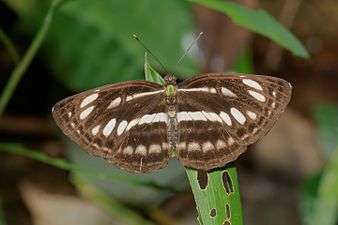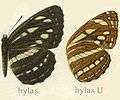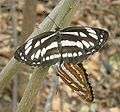Neptis hylas
Neptis hylas, the common sailor,[1][2] is a species of nymphalid butterfly found in the Indian subcontinent and southeast Asia.[1][2] It has a characteristic stiff gliding flight achieved by short and shallow wingbeats just above the horizontal.
| Common sailor | |
|---|---|
 | |
| Upperside | |
| Underside | |
| Scientific classification | |
| Kingdom: | |
| Phylum: | |
| Class: | |
| Order: | |
| Family: | |
| Genus: | |
| Species: | N. hylas |
| Binomial name | |
| Neptis hylas | |
| Synonyms | |
| |
Description
Dry-season form - Upperside black, with pure white markings. Forewing discoidal streak clavate (club shaped), apically truncate, subapically either notched or sometimes indistinctly divided; triangular spot beyond broad, well defined, acute at apex, but not elongate; discal series of spots separate, not connate (united), each about twice as long as broad; postdiscal transverse series of small spots incomplete, but some are always present. Hindwing: subbasal band of even or nearly oven width; discal and subterminal pale lines obscure; postdiscal series of spots well separated, quadrate or subquadrate, very seldom narrow. Underside from pale golden ochraceous to dark ochraceous almost chocolate; white markings as on the upperside, but broader and defined in black. Forewing: interspaces 1a and 1 from base to near the apex shaded with black, some narrow transverse white markings on either side of the transverse postdiscal series of small spots. Hindwing a streak of white on costal margin at base, a more slender white streak below it; the discal and subterminal pale lines of the upperside replaced by narrow white lines with still narrower margins of black. Antennae, head, thorax and abdomen black; the palpi, thorax and abdomen beneath dusky white.[3]
Wet-season form - Differs only in the narrowness of the white markings and in the slightly darker ground colour and broader black margins to the spots and bands on the underside.[3][4]
 Upperside on right, underside left
Upperside on right, underside left Mating pair, Bangalore, India
Mating pair, Bangalore, India In Dumbara, Rathnapura, Sri Lanka
In Dumbara, Rathnapura, Sri Lanka_Bali_I.jpg) N. h. matuta from Bali, Indonesia
N. h. matuta from Bali, Indonesia_underside_Bali_I.jpg) N. h. matuta underside from Bali, Indonesia
N. h. matuta underside from Bali, Indonesia_male_Babai_bridge.jpg) male N. h. kamarupa, Nepal
male N. h. kamarupa, Nepal_female_Godavari.jpg) female N. h. kamarupa, Nepal
female N. h. kamarupa, Nepal
This species has been observed to make sounds whose function has not been established.[5]
Distribution
Throughout continental India; Sri Lanka; Assam; Myanmar (Tenasserim), extending to China and Indomalaya.[1][2]
Life history
Larva
Race varmona = eurynome. Frederic Moore describes this from a drawing by Samuel Neville Ward as follows:
"Head larger than the anterior segment, vertex with two short pointed spines, cheeks obtusely spined; third, fourth, sixth and twelfth segments armed with a subdorsal pair of stout fleshy spiny processes, those on the fourth segment longest. Colour pale green; face, the tip of processes and segments slightly washed with pale pinkish, a slight pinkish oblique lateral fascia from an anal process; a small, dark, lateral spot on the sixth segment."[3]
Pupa
"Rather short; head-piece bluntly cleft in front, vertex pointed; thorax dorsally prominent and angular; dorsum angular at base; abdominal segments slightly angled dorsally; wing-cases somewhat dilated laterally. Colour pale brownish-ochreous, with lateral thoracic golden spots."[3]
References
- R.K., Varshney; Smetacek, Peter (2015). A Synoptic Catalogue of the Butterflies of India. New Delhi: Butterfly Research Centre, Bhimtal & Indinov Publishing, New Delhi. p. 190. doi:10.13140/RG.2.1.3966.2164. ISBN 978-81-929826-4-9.
- "Neptis Fabricius, 1807" at Markku Savela's Lepidoptera and Some Other Life Forms
-

-

- Scott, F.W. (1968). Sound produced by Neptis hylas (Nymphalidae). Journal of the Lepidopterists' Society 22(4):254
External links

